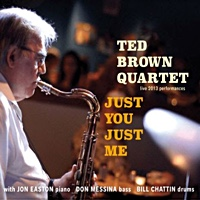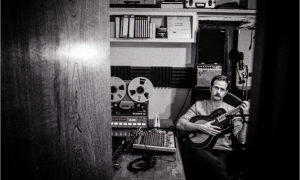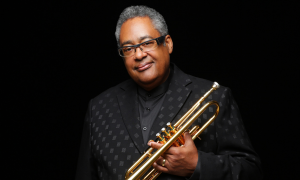Don Byas was a shadow. Too often in the 1940s, the tenor saxophonist was thought of by fans and critics as a close clone of tenor saxophone avatar Coleman Hawkins. In truth, Byas was a distinctive player in the same league as Hawkins and other saxophone greats Lester Young and Ben Webster. His thick, biting tone and gift for flawless, weaving improvisation made him a sought-after player for his pronounced sound and ability to take domineering solos.
The problem for Byas is he didn't have that something extra Hawk, Webster and Prez possessed that helped them stand out in a crowded field. Hawk's bossy presence, Webster's airiness and Prez's cool were powerful, signature essences. With the emergence of improvisational jazz in 1939 and jazz individualism, you either had that essence or you didn't, and Byas, unfortunately, found himself in Hawk's lane. [Photo above of Coleman Hawkins]
Byas spent many years anxiously trying to prove himself and carve out a space for himself. He couldn't quite figure out why he wasn't considered their equal given his acknowledged prowess. As Sonny Stitt said, “Years ago the game was vicious, cut-throat. Can you imagine Lester Young, Coleman Hawkins, Chu Berry, Don Byas and Ben Webster on the same little jam session? And guess who won the fight? That’s what it was—a saxophone duel. Don Byas walked off with everything.” [Photo above of Don Byas]
It's easy to understand Byas's frustration and confusion. He was prolific, a tireless worker and a superb musician, but he also couldn't shake his image as a Hawkins disciple rather than an innovator in his own right. As a result, he never became a household name, at least not in the U.S.
Was this unfair? It's hard to say, but it really doesn't matter. As the new 10-CD Classic Don Byas Sessions 1944-1946 from Mosaic Records demonstrates, Byas had a complete understanding of improvisation, both on up-tempo numbers and sultry ballads. He was stunning on his own terms, but it's also clear that he didn't have that little something extra that turns exceptional artists into superstars.
Part of the issue, perhaps, was his pre-war vibrato that kept him from sounding fully contemporary, especially as bebop individualists swept the jazz world between 1944 and 1946. And yet when Byas solos on the boxed set, you find yourself listening intently and admiring his fluid, smokey quality. He could navigate the saxophone with slippery ease, one moment huffing up and down chords and the next just tearing off with flawless speed.
The vitality of the Mosaic box is that it provides a comprehensive portrait of an artist over two critical years during which he mostly appeared as a sideman. The sheer number of sides he recorded at a time when independent record labels were just emerging after the first musicians union recording ban ended in 1944 tells you just how reliable, proficient and inventive he was.
The two-time Grammy-winning writer, educator and tenor saxophonist Loren Schoenberg wrote the set's extensive liner notes, which are masterful and loving, going behind the history and providing a keen understanding of Byas's turmoil and place in jazz history. The music's fidelity also is extraordinary: Lacquer transfers, sound restoration and mastering were produced by Grammy-winner Andreas Meyer and 78 transfers by Nancy Conforti and Andreas Meyer. At all stages of production, 24-bit technology was utilized.
By the fall of 1946, when Byas toured in Europe with Don Redman's band, something clicked in Paris. That December, Byas decided to permanently remain in Paris, where he felt he was better appreciated and treated. Big jazz fish in a smaller jazz pond, and all that. Like many artists who fell in love with Paris, Paris fell in love with Byas, a city where many American expatriate artists wound up doing their finest work.
For me, Byas's Paris recordings remain superb works (go here). Which is why this new Mosaic box is so essential. Across 193 tracks, we hear Byas rise to become an authoritative figure in jazz even though he never gained the crown he sought. Listening back today without the cultural influence of jazz-magazine polls, you can hear yourself saying, “Who cares whether Byas was as special as the leading tenor saxophonists of the era? This guy was incredible." Once you've stated the obvious, what remains is a beautiful player whose emotionalism and sensuality on solos was unmatched. Paris understood him completely. [Photo above of Don Byas]
Don Byas died in Amsterdam in 1972 and is still beloved by European jazz fans today.
The problem for Byas is he didn't have that something extra Hawk, Webster and Prez possessed that helped them stand out in a crowded field. Hawk's bossy presence, Webster's airiness and Prez's cool were powerful, signature essences. With the emergence of improvisational jazz in 1939 and jazz individualism, you either had that essence or you didn't, and Byas, unfortunately, found himself in Hawk's lane. [Photo above of Coleman Hawkins]
Byas spent many years anxiously trying to prove himself and carve out a space for himself. He couldn't quite figure out why he wasn't considered their equal given his acknowledged prowess. As Sonny Stitt said, “Years ago the game was vicious, cut-throat. Can you imagine Lester Young, Coleman Hawkins, Chu Berry, Don Byas and Ben Webster on the same little jam session? And guess who won the fight? That’s what it was—a saxophone duel. Don Byas walked off with everything.” [Photo above of Don Byas]
It's easy to understand Byas's frustration and confusion. He was prolific, a tireless worker and a superb musician, but he also couldn't shake his image as a Hawkins disciple rather than an innovator in his own right. As a result, he never became a household name, at least not in the U.S.
Was this unfair? It's hard to say, but it really doesn't matter. As the new 10-CD Classic Don Byas Sessions 1944-1946 from Mosaic Records demonstrates, Byas had a complete understanding of improvisation, both on up-tempo numbers and sultry ballads. He was stunning on his own terms, but it's also clear that he didn't have that little something extra that turns exceptional artists into superstars.
Part of the issue, perhaps, was his pre-war vibrato that kept him from sounding fully contemporary, especially as bebop individualists swept the jazz world between 1944 and 1946. And yet when Byas solos on the boxed set, you find yourself listening intently and admiring his fluid, smokey quality. He could navigate the saxophone with slippery ease, one moment huffing up and down chords and the next just tearing off with flawless speed.
The vitality of the Mosaic box is that it provides a comprehensive portrait of an artist over two critical years during which he mostly appeared as a sideman. The sheer number of sides he recorded at a time when independent record labels were just emerging after the first musicians union recording ban ended in 1944 tells you just how reliable, proficient and inventive he was.
The two-time Grammy-winning writer, educator and tenor saxophonist Loren Schoenberg wrote the set's extensive liner notes, which are masterful and loving, going behind the history and providing a keen understanding of Byas's turmoil and place in jazz history. The music's fidelity also is extraordinary: Lacquer transfers, sound restoration and mastering were produced by Grammy-winner Andreas Meyer and 78 transfers by Nancy Conforti and Andreas Meyer. At all stages of production, 24-bit technology was utilized.
By the fall of 1946, when Byas toured in Europe with Don Redman's band, something clicked in Paris. That December, Byas decided to permanently remain in Paris, where he felt he was better appreciated and treated. Big jazz fish in a smaller jazz pond, and all that. Like many artists who fell in love with Paris, Paris fell in love with Byas, a city where many American expatriate artists wound up doing their finest work.
For me, Byas's Paris recordings remain superb works (go here). Which is why this new Mosaic box is so essential. Across 193 tracks, we hear Byas rise to become an authoritative figure in jazz even though he never gained the crown he sought. Listening back today without the cultural influence of jazz-magazine polls, you can hear yourself saying, “Who cares whether Byas was as special as the leading tenor saxophonists of the era? This guy was incredible." Once you've stated the obvious, what remains is a beautiful player whose emotionalism and sensuality on solos was unmatched. Paris understood him completely. [Photo above of Don Byas]
Don Byas died in Amsterdam in 1972 and is still beloved by European jazz fans today.
This story appears courtesy of JazzWax by Marc Myers.
Copyright © 2026. All rights reserved.












































